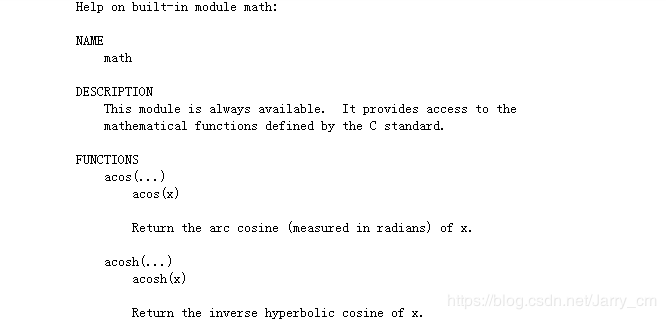小编给大家分享一下查看Python内置函数的方法有哪些,希望大家阅读完这篇文章后大所收获,下面让我们一起去探讨吧!
在用Python进行各种分析的时候,我们会用到各种各样的函数,比如,我们用SQL时,经常使用join、max等各种函数,那么想看Python是否有这个函数,这个时候可能大部分人会百度,那么如何不使用百度,而用Python本身来查找函数,学习函数的用法呢?下面,小白就总结一下自己一些经历~
比如,我们在用math模块,但是不知道这个模块下是否有自己常用的函数,那么如何做呢?
方法一
import math
dir(math)首先,我们导入这个模块,使用dir函数,就可以看到,这个模块下都有哪些函数。
['__doc__',
'__loader__',
'__name__',
'__package__',
'__spec__',
'acos',
'acosh',
'asin',
'asinh',
'atan',
'atan2',
'atanh',
'ceil',
'copysign',
'cos',
'cosh',
'degrees',
'e',
'erf',
'erfc',
'exp',
'expm1',
'fabs',
'factorial',
'floor',
'fmod',
'frexp',
'fsum',
'gamma',
'gcd',
'hypot',
'inf',
'isclose',
'isfinite',
'isinf',
'isnan',
'ldexp',
'lgamma',
'log',
'log10',
'log1p',
'log2',
'modf',
'nan',
'pi',
'pow',
'radians',
'sin',
'sinh',
'sqrt',
'tan',
'tanh',
'tau',
'trunc']这种方法是得到一个函数列表,当然,这里还可以使用help函数:
import math
help(math)
如果还是对函数不是特别了解,可以到方法的文件中去看函数的定义,利用***.__file__查看位置,然后打开后缀名为.py的文件。
import random
random.__file__结果为:这样就可以到这个py文件中查看源码
'D:\\Anaconda2\\envs\\py3\\lib\\random.py'这里需要注意一下:
***.pyc的文件是编译后的文件,打开是看不懂的,所以要看***.py文件。
在里面可以搜想看的函数,具体的定义,比如说,搜了expovariate函数,下面把该方法贴出来,这样就可以看到该方法是如何声明的辣,这样是不是也很方便,而且了解的更加透彻呢~
def expovariate(self, lambd):
"""Exponential distribution.
lambd is 1.0 divided by the desired mean. It should be
nonzero. (The parameter would be called "lambda", but that is
a reserved word in Python.) Returned values range from 0 to
positive infinity if lambd is positive, and from negative
infinity to 0 if lambd is negative.
"""
# lambd: rate lambd = 1/mean
# ('lambda' is a Python reserved word)
# we use 1-random() instead of random() to preclude the
# possibility of taking the log of zero.
return -_log(1.0 - self.random())/lambd看完了这篇文章,相信你对查看Python内置函数的方法有哪些有了一定的了解,想了解更多相关知识,欢迎关注亿速云行业资讯频道,感谢各位的阅读!
亿速云「云服务器」,即开即用、新一代英特尔至强铂金CPU、三副本存储NVMe SSD云盘,价格低至29元/月。点击查看>>
免责声明:本站发布的内容(图片、视频和文字)以原创、转载和分享为主,文章观点不代表本网站立场,如果涉及侵权请联系站长邮箱:is@yisu.com进行举报,并提供相关证据,一经查实,将立刻删除涉嫌侵权内容。